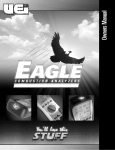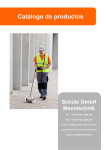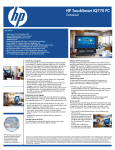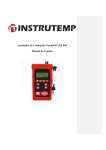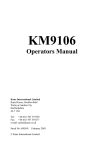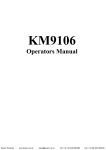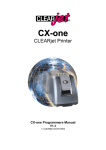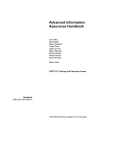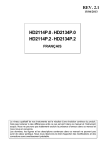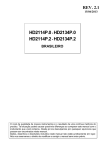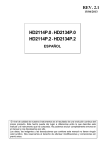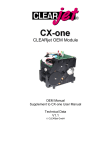Download UEi EagleX Specifications
Transcript
1
Eagle & Eagle X Owners Manual
EAGLE & EAGLE X OVERVIEW
1 . 8 0 0 . Infrared
5 4 7Printer
. 5 Port
7 4 0
•
W W W .Worklight
U E i T E S T . C O M
Display Line Lights
Navigation “s“UP
and Backlight
4 Line Backlit Display
Navigation “t“DOWN
and PUMP
SEND/ENTER
to Select and Print
On/Off Button
Rotary Test Selector Dial
Battery Compartments
in back under boot
AC Power/Charge
Indicator Light
Particle Filter
Inside Water Trap
Water Trap
Protective Rubber Boot
w/ built-in Magnets
Temperature
Connections
Flue Probe Temp: T1
Inlet Temp: T2
Pressure Connections
• Single Input (Draft): P1
• Differential Input Testing
(Pressure drop test) P2
Flue Probe
Gas Inlet Plug
Battery Charge
AC Adapter
Flue Gas
Inlet Connection
Water Trap
Drain
Flue Probe Temperature Plug
(Plugs into T1)
Narrow Pin MUST be on the
Right hand side.
2
DISPLAY PARAMETERS ON UEI COMBUSTION ANALYZERS
• TF
• T
• T∆
• O2
• CO
• CO2
• X
• EFF
• ∆
• CO a
• AMB
• CO/CO2
•
•
•
•
D
P
NO
-PO-
• -O>• -OC-
• N/F
= Flue Temperature: Calculate net temperature in °F or °C.
- Shows ambient temp after fresh air calibration and ‘- O C - ’ when probe is disconnected.
= Net Temperature:
- Differential of flue temperature minus ambient (or inlet) temperature
- Differential of T1 - T2
= Temperature Differential:
= Oxygen: O2 percentage displayed
= Carbon Monoxide: CO ppm (parts per million) displayed.
- ‘- - - -’ or ‘- OC -’ is displayed if there is a fault with the CO sensor or
the instrument has not been zeroed correctly, switch off instrument and try again.
= Carbon Dioxide:
- EAGLE (C125 & C127) Calculated from the fuel selected and the measured O2 level
- EAGLE (C125 & C127) Will display ‘- - - -’ or ‘-O>-’ if the O2 level is too
high to calculate CO2 or in fresh air.
- Calculated value is only displayed during the combustion test.
- EAGLE X (C155 & C157) Direct measurement CO2 ppm (parts per million) displayed.
= Excess Air:
- Indicated as ‘XAIR %’ on the printout
- A calculated percentage of O2 above the theoretical level required for complete combustion.
- Is required to completely burn the fuel due to poor mixing and assisting in venting flue gases
- Only displays a reading during combustion test.
- ‘- - - -’ or ‘-O>-’ is displayed in fresh air.
= Efficiency:
- Calculated based on gas readings, net temperature and fuel selected.
- Value is combustion efficiency, not appliance efficiency.
= Loss:
- Total losses calculated from Combustion Theory. A summation of the next three parameters
• Dry %: Calculated heat lost turning the Carbon in the fuel to Carbon Dioxide (CO2)
• Wet %: Calculated heat lost turning the Hydrogen in the fuel into water (H2O)
• CO Loss %: Calculated loss due to partially burnt Carbon.
Any CO in the flue has the potential to be turned into CO2 releasing and losing more
heat up the flue.
= Carbon Monoxide Air-Free: Referenced to an oxygen level of 0%.
- Do not confuse this reading with the actual CO reading as detailed above.
- See the Combustion Efficiency Calculation sections for more details.
= Air Inlet:
- Temperature used to calculate the NET temperature.
= CO/CO2 Ratio: The ratio of measured CO divided by CO2.
- It gives an indication of:
• How good a gas sample the instrument is reading.
• How clean the boiler is running.
- Example: A new or clean domestic boiler will display a ratio of less than 0.004, a unit in need
of cleaning 0.004 - 0.008 and a unit needing a major overhaul will show at least 0.008.
- Only displays a reading during combustion test. ‘- - - -’ is displayed while in fresh air.
= Draft Pressure
= Pressure
= Nitric Oxide:
= Pump Off:
- Measured gases will display this when pump is off.
= High O2 level:
- Calculated values will display this when O2 levels are greater than 18%
- Values are calculated with fuel choice and the O2 readings
= Probe Not Connected:
- Temperature values will display this when the probe is not connected or is open
- Press and hold the “PUMP” button to Zero the pressure sensor in selector positions that display
measured or calculated values “Aux” & “Flue Test”.
= Not Found:
- Displayed when not available or not installed ie: NO on a C155 or C125.
NOTE: See page 8 for complete auxiliary display listings.
3
Getting Started
SAFETY NOTES
Before using this meter, read all safety information carefully.
"WARNING" is used to indicate conditions or actions that may pose physical hazards to the user.
"CAUTION" is used to indicate conditions or actions that may damage this instrument.
WARNING!
This analyzer extracts combustion gases that may be toxic in relatively low concentrations. These gases are
exhausted from the back of the instrument. This instrument must only be used in well-ventilated locations.
It must only be used by trained and competent persons after due consideration of all the potential hazards.
PREFLIGHT CHECKLIST
•
•
•
•
•
•
•
•
Clean particle filter
• Setting Inlet Temperature
Water trap and probe line are empty of water
- Turn on and zero the analyzer with
Power on and zero
out the flue probe connected to use
All hose and thermocouple connections are properly secured
ambient temperature
Flue gas probe is sampling ambient FRESH air
- Connect flue probe thermocouple to
Water trap is fitted correctly to the instrument
T1 during zero countdown to store
Flue temperature plug is connected
probe tip temperature as inlet
Inlet temperature probe is connected if required
(ducted system)
ANALYZER CONNECTIONS
NOTE: Take care when inserting the temperature probes as the pins are polarized. Insert with the smaller
pin (+) to the right.
WARNING!
Turning the pump off while the probe is in the flue will leave toxic gases inside the analyzer. Once data
has been printed or copied it is advisable to purge the unit with fresh air as soon as possible. Use the GAS
ZERO function (Eagle X only) to purge the analyzer of excess gases. To do this on a standard Eagle remove
the probe from the flue and turn ON the pump. Always allow the readings to return to zero (20.9 for O2)
prior to shutting the unit off. The meter will not switch off until the CO reading is below 20 ppm.
WARNING!
The probe will be hot from flue gases. Remove the probe from the flue and allow it to cool naturally. Do
not immerse the probe in water, as this will be drawn into the analyzer and damage the pump and sensors.
Once the probe is removed from the flue and the readings have returned to ambient levels hold down
“On/Off” and switch off the analyzer. The instrument will count down from 30 to switch off. If
you pressed “On/Off“ by mistake, pressing “Send“ will return you to normal operation.
POST FLIGHT
(1)
(2)
(3)
Remove the probe from the flue and allow the analyzer to purge with fresh air until readings return to zero.
- O2 to 20.9%, CO to Zero (Be careful as the probe tip will be HOT)
Drain water trap
Check particle filter
Drain water trap by unplugging the drain plug and
shake to get excess water
out.
4
Check particle filter for dirt
and any other sediment and
replace if necessary.
G ETTING STARTED
WORKLIGHT AND DISPLAY
After the Analyzer has
zeroed turn test selector to
appropriate test screen.
Press “s“UP at any point to
turn on the backlit display
and worklight.
NOTE: backlight does not
work in the fuel menu.or
during purge.
Turn Power on in area of
fresh air and allow to
countdown
Rotate test selector to Fuel.
Press “s“UP or “t“DOWN
to scroll and select desired
fuel. Top line is selected fuel.
QUICK START GUIDE
QUICK START GUIDE .
Connect flue probe
thermocouple connector to T1,
and connect flue probe to
water trap as shown above.
Use optional probe with T2 for
inlet temperature.
GAS ZERO (EAGLEX SERIES ONLY)
Re-Zero the analyzer in fresh air if needed for different fuel type or after large temperature rise.
Make sure Analyzer is in
Rotate test selector to Menu. Press “s“ UP Button to
GAS ZERO and press ENTER. fresh air and press ENTER.
Analyzer will then Zero This
takes 90 seconds.
NOTE: The Eagle X will automatically initiate Gas Zero if required for continued accurate results.
BASIC CO/COMBUSTION ANALYSIS
Best results are obtained at Steady State Efficiency (SSE). Allow equipment adequate warm-up time prior to testing.
Insert Flue Probe in stack.
Rotate test selector to
Adjust the cone so the end
“Flue Test” and begin testof the probe is approximate- ing.
ly. at the center of the stack
(4” stack adjust cone to
aprox 2” from end of
probe.)
NOTE: you will have to drill a hole at least 3/8”.
Use a high temp silicone to seal after testing.
Press and Hold the “s“ UP
button to toggle between
fuel test screens 1 and 2.
Flue Test Pg.1: O2, CO, Draft
(P) and TF.
Flue Test Pg. 2: CO2, NO,
Efficiency and Excess Air.
(NO1 upgrade available on
Eagle 2 and 2X.
NO1 comes standard on
Eagle 3 and 3X.)
Make any adjustments as
needed for proper
combustion and wait for
analyzer to display any
change in the readings.
(repeat if necessary)
Once complete, remove
probe from the stack and
allow the analyzer to purge
in fresh air until CO sensor
readings return to ZERO
and O2 reads 20~21%
(20.9%). Continue to the
next test or turn off your
analyzer if finished.
NOTE: print and store functions may be used at any
point during testing.
5
DIFFERENTIAL TEMPERATURE TEST
This test is useful for quick checks of temperature rise, and differential/delta T along with other HVAC temperature applications.
Rotate test selector to Temp
Connect flue probe
thermocouple or
accessory thermocouple
connector to T1. Connect
accessory thermocouple
probe to T2. Compatible
with any K-Type
thermocouple probe or
clamp.
Place thermocouples in test
locations to start testing.
Observe T1, T2 and
Differential/delta T.
Press “SEND” to print results
or hold “SEND” to Log.
H IGH R ESOLUTION MANOMETER DRAFT & STATIC PRESSURE TEST
Rotate test selector to Prs
(Pressure)
Press and hold “t“ DOWN
button to zero pressure
sensor.
Connect true draft hose and
probe into P1. Use P2 for
Differential. Place probe tip in
stack to measure draft.
Connect static pressure hose
to P1 and P2 to measure
differential pressure..
Press “SEND” to print results
Place true draft hose and
probe tip in flue to measure or hold “SEND” to Log.
draft. You can also use the
combustion draft probe for
measuring pressure.
PRINTING AND STORING R ESULTS
Print and Log easily from the following test screens: Flue test,
Pressure/Draft/Differential, temperature and Auxiliary (Eagle X only).
Press “SEND” to start the
printout of results from any
test screen.
Press “SEND” again during
printing to cancel.
H IGH CO ALERT
Press and hold “SEND” to
log the current readings.
PRINTING LOGGED R ESULTS
To view logged results rotate the test selector to “MENU” scroll
to the “REPORT” screen and select desired test. Select “VIEW”
and scroll to desired log and view results. Press “SEND” to
print.
At 400PPM CO the screen will display HIGH CO and the indicator light will flash and analyzer will beep several times.
Above 2000PPM Screen will display HIGH CO REMOVE PROBE, the indicator light will flash and pump will pulse. Press SEND/ENTER to
continue testing or remove probe to allow analyzer to purge.
6
Great for checking for ambient CO and back drafting situations.
No probes or hose connections required for this test.
Place handset in the area to
be tested. Rotate test selector
to Room CO
Press the PUMP button to start
the test. CO readings will be
logged every 2 minute for a 30
minute time span
To view results rotate test
selector to “MENU” and
select “REPORT” Scroll to
“ROOM CO” and press
“SEND”.
Press “SEND” to VIEW
results.
Press “SEND” again to print.
QUICK START GUIDE
CO ROOM TEST
H EAT EXCHANGER TEST
There are many methods to test heat exchanger integrity. One of these is to observe the Excess Air, O2 and CO readings both before and after the
blower turns on. If the heat exchanger is sealed your O2 and CO readings should remain fairly stable. A breach in the heat exchanger may allow fresh air to
be forced into the flue after the blower turns on due to a pressure increase in the plenum. The result may be a rise in the measured O2 in the stack gas and an
increase in the Excess Air . In some sealed systems the fresh air drawn in through the breach may reduce the combustion air available leading to an increase in
the CO reading. If either of these situations are present it is probable that there is a problem with the Heat Exchanger which may require additional testing and
inspection .
NOTE: Many cracks are invisible to borescopes or the naked eye, and only open or separate from pressure or temperature changes during operations.
Rotate test selector to Exch
Test. Call for heat on the
system. Observe and wait
for O2 readings to stabilize.
Prior to the blower turning
on, and after readings have
stabilized, press the SEND
button. This will store the
Pre-Blower test segment.
After the blower turns on
press PUMP to start the
Post- Blower test.
The meter will wait 30 seconds and then record the
Post-Blower values for CO, O2
and Excess Air. Test results
will automatically be stored
to exchange reports. Report
includes both Pre and Post
Blower test segments.
To view test results rotate test
selector to “MENU” go to the
“REPORT” screen and select
EXCH. Select “VIEW” and
scroll to desired log. Press
“SEND” to print.
AUX SETTING
Programmable Auxiliary screen allows for Tech selectable test parameters to be chosen.
Rotate test selector to
“MENU” scroll “s“UP or
“t“DOWN to SCREEN.
Press “SEND”.
Scroll “s“UP or “t“DOWN Scroll “s“UP or “t“DOWN Scroll “s“UP or “t“DOWN Rotate selector to “AUX”
to select the LINE you wish to to select the function you
to AUX. Press “SEND”.
to view. Pressure is now
change. Press “SEND”.
wish to display. Press
shown in line 1 along with
(LINE 1 shown)
“SEND”. (Pressure shown)
T1, T2 and Differential/
delta T.
7
MAIN M ENU NAVIGATION
Use the “s“UP or “t“DOWN buttons to scroll through the MAIN MENU or OPTIONS. Press “SEND” to select displayed
screen choice. NOTE: Rotate the selector off menu at any time to EXIT. Selections will NOT be saved unless you press “SEND”
PRESS “s“UP to scroll through menu items in this order.
press “s“
press “s“
SUB MENU
OPTIONS
MAIN MENU
SETUP
SET TIME
SET DATE
˚F or ˚C
C < - - -> F
LANGUAGE
ENGLISH
FRENCH
SPANISH
EXIT
GAS ZERO
RESET GAS ZERO
(EagleX ONLY)
PRESSURE
SMOOTH
ON/OFF
RESOLVE
HIGH
LOW
PS UNITS
In H2O
mbar
mmH2O
Pa
kPa
PSI
mmHg
hPa
EXIT
REPORT
COMB’N
VIEW
PRESSURE
DEL ALL
EXCH
TEMP
ROOM CO
SCREEN
SERVICE
8
Notes
Use to set current time.
Use to set current date.
Use to select temperature scale.
Use to select language.
Return to main menu.
Press “SEND” to start.
Automatically returns to main menu.
Use to change screen update rate.
Use to select display resolution.
Use to select desired unit of measure. Choose beetween:
inches H2O (water gauge)
millibar
millimeters of H2O
Pascals
Kilopascals
Pounds per square inch
Millimeters of mercury
Hecto pascals
Return to main menu.
When viewing reports:
-Press “s“UP or “t“DOWN to select report #.
-Press and hold “s“UP or “t“DOWN to change the displayed
lines in VIEW.
-Press SEND to print current viewed report.
-Press and hold SEND to exit view.
EXIT
Return to Sub Menu.
Return to main menu.
EXIT
CONTRAST
00~20
Use to change screen contrast.
AUX
LINE 1
-Select parameter displayed for each line.
-Press “s“UP to choose between:
LINE 2
(shows time)
TIME
Temp differential
∆T
LINE 3
LINE 4
CO
Carbon Monoxide
DATE
(shows date)
Losses
Pressure
P
CO/CO2 Ratio
R
Excess Air
X
Efn
Efficiency
CO2
Carbon Dioxide
Oxygen
O2
NO
NO
Inlet Temp (T1)
TI
CO Air Free
COa
BAT
Battery Level
TF
Flue Temp (T2)
Draft
D
Return to Sub Menu.
EXIT
HEADER
HEADER1
Customize header information
Screen shows (*OUR COMPANY NAME &_ _ _ _)
HEADER2
-Press UP or DOWN to scroll through letters and symbols to
choose, press ENTER.
Return to Sub Menu.
EXIT
Return to main menu.
EXIT
Used by technicians to calibrate combustion gas sensors.
WHAT RESULTS ARE GENERALLY ACCEPTABLE
ATMOSPHERIC GAS FIRED BURNERS
•
•
•
•
Oxygen ....................................................................................... 7 to 9% O2
Stack Temperature ................................................................... 325 to 500°F
Draft (Water Column Inches) .................................................... -.02 to -.04wc”
Carbon Monoxide (parts per million) ...................................... <100ppm
GAS FIRED POWER BURNERS
•
•
•
•
•
Oxygen ....................................................................................... 3 to 6% O2
Stack Temperature ................................................................... 275 to 500°F
Stack Draft (Water Column Inches).......................................... -.02 to -.04wc”
Overfire Draft (Water Column Inches)..................................... -.02wc”
Carbon Monoxide (parts per million) ...................................... <100ppm
OIL FIRED BURNERS (#2 OIL FUEL)
•
•
•
•
•
•
Oxygen ....................................................................................... 4 to 7% O2
Stack Temperature ................................................................... 325 to 600°F
Stack Draft (Water Column Inches).......................................... -.04 to -.06wc”
Overfire Draft (Water Column Inches)..................................... -.02wc”
Carbon Monoxide (parts per million) ...................................... <100ppm
Smoke ........................................................................................ 0 (or manufacturer’s recommendation)
POSITIVE OVERFIRE GAS & OIL
•
•
•
•
Oxygen ....................................................................................... 3 to 9% O2
Stack Draft (Water Column Inches).......................................... -.02 to -.04wc”
Overfire Draft (Water Column Inches)..................................... +0.4 to +0.6wc”
Carbon Monoxide (parts per million) ...................................... <100ppm
NOTE: Follow manufacture guidelines for the specific equipment being serviced.
TYPICAL EXCESS AIR LEVEL
Natural gas
Light Oil
Coal
O2% (measured)
3%
5%
8%
Excess Air %
16.7%
31%
62%
PROVIDE YOUR CUSTOMER FACTS, NOT OPINIONS.
Combustion
Heat Exchanger
Differential
Temperature
Manometer
Draft/Pressure
Room CO
Auxiliary
(EagleX Only)
9
WHERE TO TEST
AIR CONDITIONING / HEAT PUMP
Suction Line:
• Temperature
Verify proper:
• Static Duct Pressures
• Temperature Differential
• Static Pressure Drop Across Coils
to condensing unit
BOILER & WATER HEATERS & HIGH EFFICIENCY MODULATING HOT WATER SYSTEMS
BOILER
Verify proper combustion:
• O2
• CO Air Free
• Stack Temp
• Stack Draft
• SSE
WATER H EATER
Draft
Verify proper combustion:
• O2
• CO
• Stack Temp
• Efficiency
HE BOILER I NSTANT
WATER H EATERS
Draft
Verify proper
combustion:
• O2
• CO
• Stack Temp
• Efficiency
Hi / Low fire Gas
Pressure
Send and Return
Water temp
FURNACES: 80%
FURNACES: 90%
80% FURNACE
Verify proper combustion:
• O2
• CO
• Stack Temp
• Vent Pressure
• Efficiency
90%+ FURNACE
Verify proper combustion:
• O2
• CO
• Stack Temp
• Vent Pressure
• Efficiency
Verify/Set Up
• Gas Pressure
Verify/Set Up
• Gas Pressure
Test
Test
• Limit Switch
• Pressure Switch
Verify proper operation:
• Static Duct Pressure
• Temperature Rise
• AC side Static Pressure
Drop across coils
10
• Limit Switch
• Pressure Switch
Verify proper operation:
• Static Duct Pressure
• Temperature Rise
• AC side Static Pressure
Drop across coils
FURNACES (CONTINUED): ATMOSPHERIC, GAS & OIL
ATMOSPHERIC FURNACE
Draft
Verify proper
• Temperature Rise
• AC side Static Pressure Drop across coils
Verify proper combustion:
• O2
• CO
• Stack Temp
• Efficiency
NATURAL GAS & PROPANE
Verify proper combustion:
• O2
• CO
• Stack Temp
• Vent Pressure
• Efficiency
Test
• Limit Switch
• Pressure Switch
Set Up
• Gas Pressure
Verify proper:
• Static Duct Pressure
• Temperature Rise
• AC side Static Pressure Drop across coils
OIL FURNACE
Verify proper combustion:
• O2
• CO
• Stack Temp
• Stack Draft
• Efficiency
Test & Verify:
• Smoke
Set Up
• Over Fire Draft
Verify proper
• Static Duct Pressure
• Temperature Rise
• AC side Static Pressure Drop across coils
11
OTHER IMPORTANT FACTORS RELATING TO COMBUSTION
• The three T’s of combustion
– Time
• Amount of time that the fuel and oxygen are together in the combustion chamber
– Temperature
• How high the temperature is determines the rate of oxidation, or speed of the combustion
– Turbulence
• How well the fuel and air are mixed
• These three factors are all interrelated, and will move your results along the combustion curves.
COMBUSTION MEASUREMENT TERMS
Other parameters measured include net temperature, draft and efficiency.
Net Temperature
Net temperature is the difference between the combustion air entering the combustion chamber and the flue gas temperature past
the heat exchange. This is used to determine how efficient the system is extracting heat from the combustion process in addition to
the performance of the combustion process. On sealed systems that have ducted inlet air for combustion air, the net temperature
must compare this air stream temperature with the flue gases. If the appliance simply uses room air for the combustion air, our
analyzers have an internal temperature sensor in the handset, so it will use this temperature when calculating net temperature.
The most accurate results for efficiency are obtained when measuring flue gases at the point where flue temperature (not flame temperature) is the highest.
Draft
Draft is the difference between the ambient pressure level and the pressure level in the flue. This is created either by the natural
buoyancy of the hot gases created in combustion lifting, or by an inducer fan that assists the flow of flue gases up the stack. Most
combustion equipment will specify the amount of draft that is required for proper operation.
Draft helps draw combustion air into the combustion chamber, and also helps in mixing the fuel and oxygen. Without proper
draft, the combustion process can spill poisonous by-products into the space where the appliance is located. This can be a risk to
those in the area, or create a danger to residents or employees working near the combustion equipment.
Efficiency
Efficiency is a measure of how well the fuel is burned to create heat, and how well the generated heat is captured for the intended
use.
The information used to create this value are based on the fuels heating value, the heat lost up the flue and the gas components in
the flue gas. The original method to determine efficiency included many manual methods and lookup charts. As an example you
would measure the CO2 level and the stack temperature and then reference a slide scale that would give you the relative efficiency
number. UEi’s electronic combustion analyzers perform the measurements on a continuous basis, and can calculate the efficiency
as adjustments are being made. Combine this with a printout and you are able to provide a before and after comparison of the
combustion equipment in relatively little time as part of normal servicing.
12
CO AIR FREE
Certain standards ( ANSI Z21.1) for Carbon Monoxide are stated in terms of air-free. Air-free refers to the concentration of CO in combustion gases undiluted with flue, or other gases containing little CO. This value is computed using an equation that takes into account the O2 concentration of the flue gas.
• If 5% O2 is measured (O2m) in the flue then the CO gas value will be recalculated as if 0% were measured.
The equation for air-free is as follows:
- COaf = CO PPM x [(20.9) / (20.9 - O2m)]
• In our example if a reading of 325 PPM were measured then the air-free value would be calculated as follows:
- COaf = 325 PPM x [(20.9) / (20.9 - 5)] COaf = 325 PPM x [(20.9) / (15.9)] COaf = 427
We may be given a limit on our gas range by the local authority, which stated that we must not emit more than
400-PPM Carbon Monoxide air-free. In the example we would be breaking the limit and corrective action should be
taken to reduce the level of CO. Air-free values prevent false readings being submitted, e.g. allowing more air into the
boiler will increase the oxygen level in the flue and dilute any toxic gas reading. Air-free referencing gives readings as if
they were undiluted.
COMBUSTION EFFICIENCY CALCULATIONS
This identifies three sources of loss associated with fuel burning:
• Losses due to flue gasses:
- Dry Flue gas loss, Moisture and hydrogen,
- Sensible heat of water vapor, Unburned gas
• Losses due to refuse:
- Combustible in ash, riddling and dust
• Other losses:
- Radiation, convection, conduction other unmeasured losses
Net efficiency calculations assume that the energy contained in the water vapor (formed as a product of
combustion and from wet fuel) is recovered and the wet loss term is zero. Gross efficiency calculations assume that the
energy contained in the water vapor is not recovered. Since the fuel air mixture is never consistent there is the possibility of unburned/partially unburned fuel passing through the flue. This is represented by the unburned carbon loss.
Losses due to combustible matter in ashes, riddling, dust and grit, radiation, convection and conduction are not
included.
Efficiency Calculation:
• Known Data Fuel:
- Qgr = Gross Calorific Value (kJ/kg)
- Qnet = Net Calorific Value (kJ/kg)
- K1 = Constant based on Gross or Net Calorific • •
• Known Data Value:
- K1g = ( 255 x %Carbon in fuel )/Qgr
- K1n = ( 255 x %Carbon in fuel )/Qnet
- K2 = % max theoretical CO2 (dry basis)
- K3 = % Wet Loss
- H2 = % Hydrogen
- H2O = % Water
• Measured Data:
-Tf = Flue Temperature
-Ti = Inlet Temperature
-O2m = % Oxygen in flue gas
-O2r = Oxygen reference %
• Calculated data:
- Tnet = Net Temperature
- % CO2 content in flue gas
-% Dry Flue Gas losses
-% Wet losses
-% Unburned carbon loss
-% Efficiency
• Tnet = Flue Temperature - Inlet Temperature (or ambient)
• Dry flue gas loss %
= 20.9 x K1 x (Tnet) / K2 x (20.9 - O2m)
• Wet loss %
= 9 x H2 + H2O / Qgr x [2488 + 2.1Tf - 4.2 Ti]
• Simplified
= [(9 x H2 + H2O) / Qgr] x 2425 x [1 + 0.001 Tnet]
• Wet loss %
= K3(1+0.001xTnet)
• Where K3
= [(9 x H2 + H2O) / Qgr] x 2425
• Net Efficiency %
= 100 - dry flue gas losses
= 100 - 20.9 x K1n x (Tnet) / K2 x (20.9 -O2m)
• Gross Efficiency %
= 100 - {dry flue gas losses + wet losses}
= 100 – {[20.9 x K1g x (Tnet) / K2 x (20.9 - O2m)]+
[K3 x (1 + 0.001 x Tnet)]}
• Excess Air
= [20.9 / (20.9 - O2m) - 1] x 100
• CO2%
= [(20.9 - O2m) x K2 / 20.9]
• Unburned
= K4 x CO / ( CO + CO2 )
Note: CO scaled in % fuel Loss %
• Where K4
= 70 for coke
= 65 for anthracite
= 63 for Bituminous coal
= 62 for coal tar fuel
= 48 for liquid petroleum fuel
= 32 for natural gas
The formula for K4 is based on the gross calorific value
Qgr. To obtain the loss based on net calorific value multiply by Qgr/Qnet. Since this loss is usually small this conversion has been ignored. This loss is subtracted from the
efficiency.
13
GENERAL MAINTENANCE
GENERAL MAINTENANCE
•
•
•
•
Calibrate your instrument annually to ensure it meets original performance specifications
Keep your instrument dry. If it gets wet, wipe dry immediately. Liquids can degrade electronic circuits
Whenever practical, keep the instrument away from dust and dirt that can cause premature wear
Although your instrument is built to withstand the rigors of daily use, it can be damaged by severe
impacts. Use reasonable caution when using and storing the meter
PERIODIC SERVICE
WARNING!
Repair and service of this instrument is to be performed by qualified personnel only. Improper repair or
service could result in physical degradation of the instrument. This could alter the protection from personal
injury this meter provides to the operator. Perform only those maintenance tasks that you are qualified to do.
ANNUAL RE-CALIBRATION
While the sensor has an expected life of more than two years in normal use it is recommended that the
analyzer is re-calibrated at least annually, This is so that long-term drift on the sensor and electronics can be
eliminated. Local regulations may require more frequent re-calibration and users should check with
appropriate authorities to ensure they comply with relevant guidelines.
CLEANING
Periodically clean your instruments case using a damp cloth. DO NOT use abrasive, flammable liquids,
cleaning solvents, or strong detergents as they may damage the finish, impair safety, or effect the reliability
of the structural components.
EMPTYING & CLEANING THE IN-LINE WATER TRAP
The in-line water trap should be checked and emptied on a regular basis. Water vapor will condense in the
probe line, which may cause the water trap to fill suddenly if the probe is moved. Care should be taken
at all times.
Carefully remove the rubber plug from the bottom
of the water-trap housing. Dispose of the condensate in
a suitable drain, care must be taken as it could be acidic.
If condensate spills onto the skin or clothing, clean off
immediately using fresh water, seek medical advice
if problems occur. Ensure plug is replaced before
performing combustion tests. Note: O2 reading will
be high if the Water Trap Plug is not in place.
Hook slides
out of dock
Slide outward
Pull plug out
to drain
CHANGING THE PARTICLE FILTER
This is a very important part of the analyzer and should be changed regularly. It prevents dust and dirt
particles from entering the pump and sensors that will cause damage. The filter MUST be changed when
it appears discolored on the inner surface.
Remove water-trap assembly from the analyzer
as shown above. Remove the filter and plastic
holder from the housing. Discard the filter
element but keep the holder to fit to the new
filter. Clean the inside of the filter housing
with a suitable soft cloth. Fit the holder onto
the new filter element and then insert into the
housing. Refit the housing onto the analyzer.
14
Insert a new filter
BATTERIES REPLACEMENT
This meter has been designed for use with both alkaline
and rechargeable Nickel Metal Hydride (NiMH) batteries.
No other types are recommended. The analyzer is supplied
with 4 “AA” size alkaline batteries.
These should be installed into the instrument as shown
in the diagram to the right and indicated on the back of
the unit.
Note: Follow battery
directions on back of
housing
C75 Directions
C125/C127, C155/C157
Directions
OR
Back of
Instrument
Battery Compartment
CAUTION!
Take great care when installing the batteries to observe
correct polarity. Always check the meter for operation
immediately after installing new batteries.
Cover
USING RE-CHARGEABLE BATTERIES
The battery charger must only be used when NiMH batteries are fitted. Alkaline batteries are not
re-chargeable. Attempting to recharge alkaline batteries may result in damage to the product and may
create a fire risk.
BATTERY CHARGING
Ensure that you use the correct charger. This unit uses a 9V DC regulated charger.
Ensure that the batteries are fitted in the correct manner, and then charge for at least 16 hours. Subsequent
charges should be overnight. NiMH batteries may be charged at any time, even for short periods to
conduct testing.
WARNING!
Under NO circumstance should you expose batteries to extreme heat or fire as they may explode and cause
injury. Always dispose of old batteries promptly in a manner consistent with local disposal regulations.
ELECTROMAGNETIC COMPATIBILITY (EMC)
This product has been tested for compliance with the following generic standards:
EN 50081-1, EN 50082-1 and is certified to be compliant.
The European Council Directive 89/336/EEC requires that electronic equipment does not generate
electromagnetic disturbances that exceed defined levels and has an adequate level of immunity to enable it to
be operated as intended.
Since there are many electrical products in use that pre-date this Directive and may emit electromagnetic
radiation in excess of the standards defined in the Directive there may be occasions where it would be
appropriate to check the analyzer prior to use. The following procedure should be adopted.
•
•
•
•
Go through the normal start up sequence in the location where the equipment is to be used
Switch on all localized electrical equipment that might be capable of causing interference
Check that all readings are as expected (a level of disturbance in the readings is acceptable)
If not, adjust the position of the instrument to minimize interference or switch off, if possible, the
offending equipment for the duration of the test
At the time of writing this manual (July 2009) UEi is not aware of any field based situation where such
interference has ever occurred and this advice is only given to satisfy the requirements of the Directive.
15
EAGLE SPECIFICATIONS
C125
C127
Temperature Measurement
Flue Temp Range
Inlet Temperature (probe - T2)
Inlet Temperature (ambient)
Net Temperature (_T)**
Resolution
Flue (T1, Inlet T2 & _T) Accuracy
Inlet Temperature Accuracy
Gas Measurement
Oxygen
O2 resolution / accuracy
Carbon Monoxide (CO)
CO resolution / accuracy
C157
20~2400˚F (-29~1315˚C)
20~2400˚F (-29~1315˚C)
32~112˚F (0~50˚C)
20~2400˚F (-29~1315˚C)
0.1˚C/F
±(0.3% rdg +3.6˚F(2˚C))
±(0.3% rdg +1.8˚F(1˚C))
0~21%*
0.1% / ±0.2%
Carbon Dioxide (CO2)
CO2 resolution / accuracy
Efficiency**
Efficiency resolution/accuracy
Excess Air**
Excess Air resolution/accuracy
CO/CO2 ratio**
CO/CO2 resolution/accuracy
Nitric Oxide (NO1)
NO1 resolution/accuracy
C155
0~30%**
0.1% / ±3%
0~99.9%**
0.1% / ±3%
0~250%**
0.1% / ±3%
0~0.999
0.001 / ± 5% rdg
-
Pressure (Differential)
0~21%*
0~21%**
0.1% / ±0.2%
0.1% / ±0.3%
0~2000 ppm (4000 max 15 min)*
1ppm/ ±10ppm<100ppm
±5% rdg>100ppm
0~30%**
0~20%*
0.1% / ±3%
0.1% / ±2%
0~99.9%**
0~99.9%**
0.1% / ±3%
0.1% / ±3%
0~250%**
0~250%**
0.1% / ±3%
0.1% / ±3%
0~0.999
0~0.999
0.001 / ± 5% rdg
0.001 / ± 5% rdg
-0~100 ppm
±2 ppm<30ppm
±5 ppm<100 ppm
-
Range
±0.08” wc (±0.2mBar)
±0.4” wc (±1mBar)
±32” wc (±80mBar)
Pressure Resolution
0~21%**
0.1% / ±0.3%
0~20%*
0.1% / ±2%
0~99.9%**
0.1% / ±3%
0~250%**
0.1% / ±3%
0~0.999
0.001 / ± 5% rdg
0~100 ppm
±2 ppm<30ppm
±5ppm<100 ppm
Accuracy
±0.002” wc (±0.005mBar)
±0.01” wc (±0.03mBar)
±3% rdg
0.001” wc < 9.999” wg
0.01” wc >10.00” wg
0.001mBar<24.999mBar
0.01mBar > 25 mBar
* Measured at STP (standard temperature and pressure)
** Calculated value
EAGLE & EAGLE X LIMITED WARRANTY
The Eagle Combustion Analyzers (C75, C125, C127) are warrantied to be free from defects in materials and workmanship for a period of
three years (two years on sensors) from the date of purchase. Eagle X (C155, C157) are each warrantied for five years including sensors.
If within the warranty period your instrument should become inoperative from such defects, the unit will be repaired or replaced at UEi’s
option. This warranty covers normal use and does not cover damage which occurs in shipment or failure which results from alteration,
tampering, accident, misuse, abuse, neglect or improper maintenance (calibration). Batteries and consequential damage resulting from failed
batteries are not covered by warranty.
Any implied warranties, including but not limited to implied warranties of merchantability and fitness for a particular purpose, are limited
to the express warranty. UEi shall not be liable for loss of use of the instrument or other incidental or consequential damages, expenses, or
economic loss, or for any claim or claims for such damage, expenses or economic loss. A purchase receipt or other proof of original purchase
date will be required before warranty repairs will be rendered. Instruments out of warranty will be repaired (when repairable) for a service
charge. Contact UEi for specific warranty and service information. This warranty gives you specific legal rights. You may also have other
rights which vary from state to state.
U S A : 1. 8 0 0 . 5 4 7. 5 74 0 • F a x : 5 0 3 . 6 4 3 . 6 3 2 2
C A N A D A : 1 - 8 7 7- 4 7 5 - 0 6 4 8 • F a x : 6 0 4 . 2 7 8 . 8 2 9 9
W W W. U E i T E ST. C O M
COPYRIGHT © 2009 UEi. EAGLE Combustion Analyzers™ is a trademark of UEi.
PRIN109/3k 10/09 18323
















